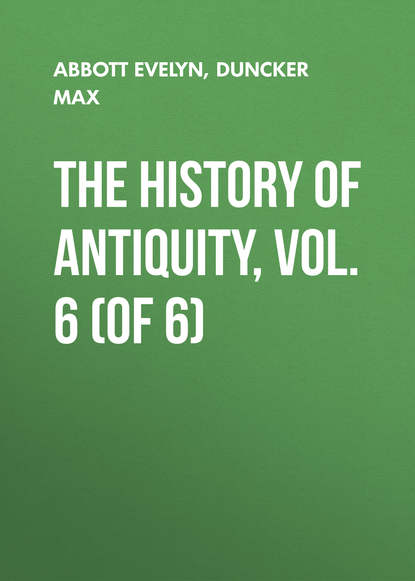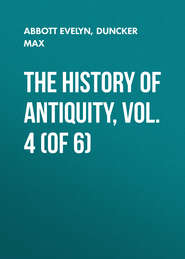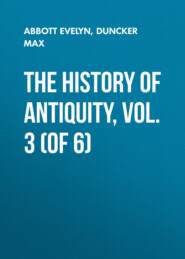По всем вопросам обращайтесь на: info@litportal.ru
(©) 2003-2024.
✖
The History of Antiquity, Vol. 6 (of 6)
Настройки чтения
Размер шрифта
Высота строк
Поля
At a later time Xerxes caused Sataspes to sail round Africa.
254
Herod. 4, 1.
255
Herod. 4, 85, 87.
256
360 triremes and penteconters were used for the bridge of Xerxes. Herod. 7, 36.
257
Herod. 4, 87.
258
Polyb. 4, 39.
259
Strabo, p. 319, 320. Opposite the temple of the Chalcedonians on the mouth of the Pontus, which was sacred to Zeus Urias (now Anadoli Kavak), there lay on the European shore also on the mouth of the Pontus a temple of the Byzantines which later authors call the Serapeum (now Rumili Kavak). Scyl. "Peripl." 67.
260
Herodotus allows the Bosphorus a breadth of four stades; Strabo in one passage mentions four, in another five; p. 125, 319. Modern authors do not agree in their measurements (Grote, "Hist. of Greece," 5, 26), but give about 1¼ mile, i. e. above 5000 feet for the narrowest part, and five miles for the widest. For the narrowest place most authorities allow about 3900 feet, i. e. 6½ stades; cp. Kruse, on Herodotus' measurement of the Pontus, s, 41. On the other hand, Moltke ("Briefe," s. 82) gives the following: At the northern mouth between the light-houses, 4166 paces; at Tell Tabia, 1497 paces; between the castles, 958 paces.
261
"Anapl. P. E." frag. 35. Choerilus, in Strabo, p. 303.
262
Herod. 4, 88.
263
The chronology of the conquests of Darius is not easy to fix. In Herodotus the campaign against Samos is contemporaneous with the rebellion of the Babylonians (3, 150). If Darius had had armies at his disposal from Samos there, he would not have needed to send Bagaeus. The expedition to Samos must be placed after the end of the rebellion, i. e. at the earliest in the year 517, and it cannot be put later than a year at the least before the Scythian expedition, since the ships of Samos, led by Syloson's son, take part in that expedition, and in addition to Samos the cities of the Bosphorus are in the hands of the Persians before that event. The expedition to investigate the shores of Greece, in which Democedes took part, is placed by Herodotus before the attack upon Scythia. This is improbable, because the experience which Darius gained in the Scythian expedition, and which made it seem desirable to put the command in Persian hands, preceded this expedition. There is nothing to point to it before the expedition; it first becomes intelligible when Darius had resolved to change his plan of conquests in the north for conquests in the west, and had given Megabyzus orders to subjugate the coasts of Thracia on the Ægean, – when Megabyzus had advanced to the Strymon and Macedonia had recognised the sovereignty of Persia. On the other hand, the investigation of the Greek coasts cannot be put much later than 512, since Milo of Crotona, who is still of great influence in that region, as Herodotus himself remarks (3, 137), betroths his daughter to Democedes. This influence Milo retained only as far as the year 510 or 509; for soon after the victory over Sybaris and the destruction of the city, which took place 511 or 510 B.C., the rising against Pythagoras and the aristocracy took place; they were overthrown and expelled. In Herodotus the Scythian expedition comes after the capture of Babylon (4, 1). We have seen from the inscriptions (p. 254), that there were two rebellions of Babylon, and that they cannot have come to an end before the close of the year 517. Now Samos was subjugated before this Scythian expedition; moreover Byzantium and the Chersonese must have been in the hands of the Persians; at least a year must have been occupied with the preparations required to bring 700,000 men to the Bosphorus, and with the preparations for building the bridge (Herod. 3, 83). Hence the campaign cannot have commenced before the year 515 B.C. and it cannot be put later than 510 B.C. Miltiades is already master of the Chersonese when Darius crosses the Danube; according to Herodotus it is the Pisistratids (not Hippias) who sent him there. Hence Miltiades was master of the Chersonese before 514 B.C., the year in which Hipparchus was murdered. Again, when Miltiades has to retire from the Chersonese before the return of Darius, he does not go to Athens, from which it follows that Hippias was still tyrant in Athens. Thucydides tells us that when Hippias, after the murder of Hipparchus, was looking about for alliances he married his daughter to Aeantides, the son of Hippoclus, tyrant of Lampsacus, because he saw that Hippoclus was in great repute with Darius. This influence Hippoclus must have gained in the Scythian expedition; he led the ships of his city to the Danube and voted for remaining there. Hence this expedition must be put some time before 510 B.C. If we allow two years for the battles of Megabyzus in Thrace, and the march of Bubares to Macedonia after the Scythian war, and place, as is natural, the expedition to the coasts of Hellas, which falls in the year 512 B.C., after these acquisitions, we might keep to the year 515 for the Scythian expeditions. But as the Indian conquests precede the Scythian war, the year 513 B.C. seems still better. The expedition to Barca is, in Herodotus, contemporaneous with the conflicts of Megabyzus against those "who were not of Median opinions" (4, 145). This contemporaneous date is supported by the fact that Greek ships only, and not Phenician, are ordered to the Danube, and to support the communications of Megabyzus with Asia, – a circumstance which is best explained by the absence of the Phenicians in the African expedition. Moreover, Justin (19, 1) speaks of an embassy of Darius to Carthage at the time when this city was engaged in a conflict with Doreus of Sicily (Herod. 5, 45-48; 7, 165; Diod. 4, 23). Such an embassy, which could only be sent to demand a recognition of supremacy or union in war against the Greeks, was first suggested when the Persians reached as far as the Euhesperides and Persia became a neighbour of Carthage, i. e. after the expedition to Barca. The colony of Dorieus on the Eryx was planted between 510 and 508; he had previously taken part in the battle on the Traeis in 311 or 510 B.C. The embassy of Darius to Carthage would therefore be subsequent to the campaign to Barca and the expedition of Democedes, and the years 513 and 512 seem most suitable for the first. From the inscriptions of Darius it is clear that the inscription of Persepolis, when compared with the inscription of Behistun, enumerates more subject lands. The former speaks of the Ionians of the continent and the Ionians of the sea (daraya), while the inscription of Behistun merely mentions the Ionians. By the Ionians of the sea we are to understand the newly-subjugated Greeks of Samos, the Greek cities on the Bosphorus and Propontis. Moreover, the inscription of Persepolis, as already mentioned, speaks of Idhus (p. 260), while the inscription of Behistun speaks of Gandaras only. It follows from this that the first undertakings of Darius after crushing the rebellion were the wars in the east, the conquests of Samos and the Greek cities on the straits. This is established by the statement of Herodotus that the Indians were included in the first division into satrapies – which he places soon after the accession of Darius – but the islands and the Thracians were added later on. The palace at Persepolis must therefore have been built about the year 515 B.C. after the war upon the Indians and the expedition to Samos, after the subjugation of the strait, but before the campaigns against Scythia and Barca. The Scythian campaign falls in the year 513, the conquests of Megabyzus and Otanes in 512, the campaign against Barca in 513 and 512, the expedition for the investigation of the Greek coasts in 512 or 511. The inscription on the tomb of Darius does not mention Ionians of the continent and Ionians of the sea, but Ionians merely in one case, and then Yauna takabara, i. e. Ionians who wore locks, by whom may be meant the Greeks of Lemnos and Imbros, the Greek cities of the Thracian coast, and the Macedonians, i. e. the regions which were first subjugated after the Scythian campaign. It will be made clear below that the last names in the inscription on the tomb are to be explained of African tribes, i. e. of the result of the expedition against Barca. By the Çkudra, mentioned on the inscription, we may understand the Thracians; in the place of the Çaka who are mentioned without any addition at Behistun and Persepolis, the sepulchral inscription has three kinds of Çaka: —Çaka humavarka, who must be interpreted to mean the Amyrgian Sacae of Herodotus; Çaka tigrakhauda, i. e. Sacae with pointed caps; and finally Çaka taradaraya, i. e. Sacae beyond the sea, who must be the Scoloti.
264
Herod. 4, 89-91.
265
Herod. 4, 90-92. "Geographical Journal," vol. 24, p. 44 ff, where is also to be found the report of General Jochmus on the supposed inscription in cuneiform letters and on the stone-heaps, which, according to Herodotus, the soldiers of Darius piled up at Artiscus.
266
Herod. 4, 93, 94; Strabo, p. 305; Thuc. 2, 96.
267
Herod. 4, 97, 98.
268
Vol. III. 235. Neumann, "Hellenen in Skythenlande," s. 200, 211, 215.
269
Vol. III. 229.
270
Neumann, loc. cit. s. 223 ff.
271
Justin, 2, 3, 5.
272
Ctes. "Pers." 16.
273
Strabo, p. 305.
274
Strabo, p. 737.
275
Pherecyd. fragm. 113, ed. Müller.
276
Hic quum crebri afferrent nuntii male rem gerere Darium premique ab Scythis, Miltiades hortatus est, etc. Nepos, "Miltiades," 4, in any case following Ephorus.
277
Herod. 5, 27. It is clear that the Antandrians and Lamponians were accused only of abandoning the campaign, not of imperilling the retreat.
278










